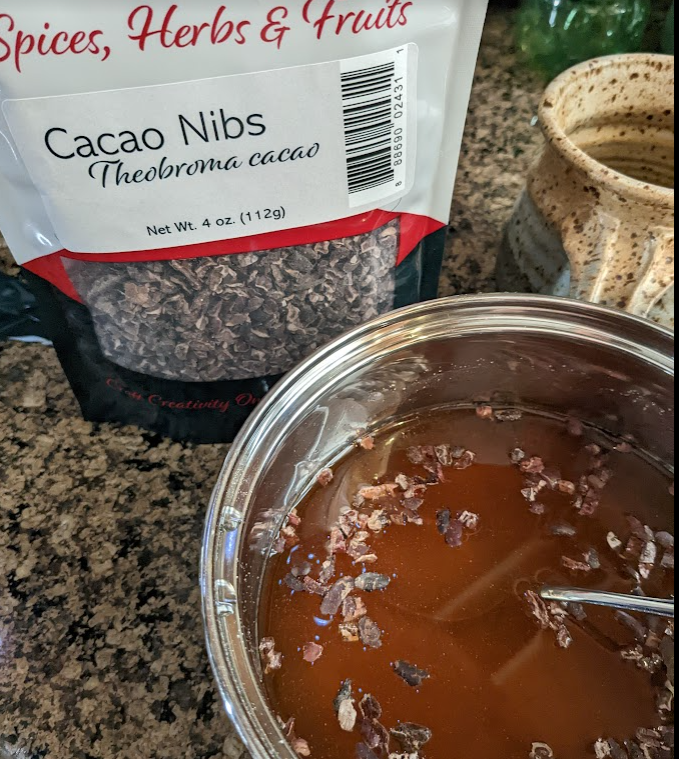Making a Virginia/Burley whole leaf plug


This will be a pretty obvious amateurish attempt at making a Virginia/Burley whole leaf plug in a similar vein as Germain’s Rich Dark Flake. I expect it not be even close but you got to put a stake in the ground somewhere on this 60/40 Virginia/Burley blend.

Burley casing is 1 to 1 sugar to water ratio by weight. Start about a cup of sugar and then match the weight in water. Toss in a cap full of white vinegar, a tablespoon of black molasses and tablespoon of cacao nibs. I got the cacao nibs from a beer brewer supply shop online. Bring the whole thing to a boil for a 5-10 minutes, take off the heat and let it cool.

While the burley casing was cooling and de-stemmed 1 lb of whole leaf burley. I’m not going to use all of it for this recipe but might as well get it done. It takes a bit of time de-stemming burley. Basically I unravel the leaf, fine the stem at the tip of the leaf and pull down. Toss the leaves in a bag and stems in the trash. You could grind up the stems to make snuff but I seem to already have a lifetime supply of snuff in the stash. Once de-stemmed I hand rip the leaves in the bag buy grabbing a pile with both fists and twist to rip apart. This also helps me find stems that slipped through the cracks in quality control.

Casing wasn’t hot but still warm I fill a 2 oz atomizer bottle and start spraying and turning the leaves. Normally 2 oz would be enough for a 1 lb of leaves but I went with 3 ounces with this batch. Next was just tie up the bag for a couple of hours before blending.
Trying something new with the bright Virginia casing. Again the base is 1 to 1 sugar to water by weight with a cap full of white vinegar. I added a tablespoon of Brewer’s Plum that I got from the beer supply online store. Brought the whole thing to a boil for 5 -10 minutes and let cool. While boiling I de-stemmed 1 lb of bright Virginia and hand shredded just like the step with the burley.
After the casing came off the heat and cooled enough it was time to case the bright Virginia . Again turning and spraying like the burley casing step. I also went 3 ounces of casing for 1 lb of bright Virginia. Tried up the bag for several hours to let the do it’s thing.
Making the plug I measured out 120 grams of bright Virginia and 80 grams of burley. Placed both into a bag and hand tossed to blend the components. The steel mold is 3″ x 3″ and perfect for 200 gram plug. Go with something smaller you can use a 3″ PVC, C-Clamp and two hockey pucks and do a 100 gram plug. Smaller still is a noodle press which is perfect for 50 gram plugs. In all methods make sure you have wax paper on the top and bottom of the plug. Placed my steel mold in the frame press which will compress to about 2 1/2″ in height. This could be done with an 8″ C-Clamp but I will warn you it will take about 10 days of constant cranking to get down to the final size.

Once fully compressed then put the C-Clamp on it and keep it compressed and store in the cab of the truck for a poor man’s hot press. Here in the south it will be 100+ degrees in the cab most of the day.
Pulling from the form by banging on a 1×1 stick came out nice and dense. The smell of plums come off the block of tobacco. I decided I want to go ahead and slice up the whole plug and jar it right away. I would like to get a couple of months of age in to see how the blend turned out.

Of course I packed a bowl after a little drying out and here are the initial thoughts. The plum cased Virginia is dominate. The molasses on the burley is way in the background. So no, this is not Gemain’s Rich Dark Flake, sorry folks. Maybe age will change the aspect as this is a really young plug. However, this is a very pleasant smoke. no burley bite at all. Single light got most of the way down the bowl. The burley was balanced out by the Virginia and a little bit of burley aftertaste after the bowl was done.
Update 10/22: One note on burley. Once you case it, use all of it or keep it well ventilated. What I didn’t use for this plug had to be tossed as the bag that I twisted up with unused cased burley turned to mold. Likely the closed environment plus the moisture of the casing caused the mold spores to wake up.
